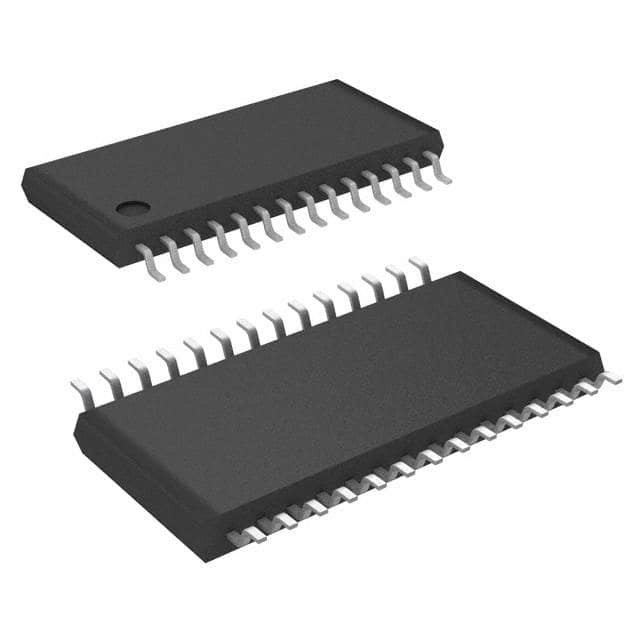Viz Specifikace pro podrobnosti o produktu.

N79E855AWG
Product Overview
- Category: Microcontroller
- Use: Embedded systems, IoT devices, consumer electronics
- Characteristics: Low power consumption, high performance, versatile
- Package: 48-pin QFN package
- Essence: A powerful microcontroller designed for various applications
- Packaging/Quantity: Available in reels of 2500 units
Specifications
- Architecture: 8-bit RISC
- Clock Speed: Up to 24 MHz
- Flash Memory: 8 KB
- RAM: 1 KB
- Operating Voltage: 2.4V - 5.5V
- I/O Pins: 36
- Communication Interfaces: UART, SPI, I2C
- Timers/Counters: 3
- Analog-to-Digital Converter (ADC): 10-bit, 8 channels
- PWM Channels: 4
- Operating Temperature: -40°C to +85°C
Detailed Pin Configuration
The N79E855AWG microcontroller has a total of 48 pins, each serving a specific purpose. Here is a detailed pin configuration:
- Pins 1-8: Port 0 (P0.0 - P0.7)
- Pins 9-16: Port 1 (P1.0 - P1.7)
- Pins 17-24: Port 2 (P2.0 - P2.7)
- Pins 25-32: Port 3 (P3.0 - P3.7)
- Pins 33-40: Port 4 (P4.0 - P4.7)
- Pins 41-48: VDD, GND, RESET, XTAL1, XTAL2, PSEN, ALE, EA/VPP
Functional Features
- Low Power Consumption: The N79E855AWG microcontroller is designed to operate efficiently with minimal power consumption, making it suitable for battery-powered devices.
- High Performance: With a clock speed of up to 24 MHz and a powerful 8-bit RISC architecture, this microcontroller offers excellent performance for various applications.
- Versatility: The microcontroller supports multiple communication interfaces (UART, SPI, I2C) and features such as timers/counters, PWM channels, and an ADC, providing flexibility for diverse projects.
Advantages and Disadvantages
Advantages: - Low power consumption - High-performance capabilities - Versatile features for different applications - Compact 48-pin package - Wide operating voltage range
Disadvantages: - Limited flash memory and RAM capacity compared to higher-end microcontrollers - 8-bit architecture may not be suitable for complex tasks requiring extensive processing power
Working Principles
The N79E855AWG microcontroller follows the principles of an 8-bit RISC architecture. It executes instructions stored in its flash memory, utilizing its various peripherals and communication interfaces to interact with external components. The microcontroller's clock speed determines the rate at which instructions are processed, enabling it to perform tasks according to the programmed logic.
Detailed Application Field Plans
The N79E855AWG microcontroller finds applications in various fields, including:
- Embedded Systems: Used in industrial automation, robotics, and control systems.
- IoT Devices: Enables connectivity and control in smart home devices, wearables, and environmental monitoring systems.
- Consumer Electronics: Powers appliances, remote controls, gaming peripherals, and other consumer electronic devices.
Detailed and Complete Alternative Models
- N76E003AT20: An alternative 8-bit microcontroller with similar features but a different pin configuration.
- NUC123ZD4AN0: A 32-bit microcontroller with enhanced processing power and additional peripherals.
- STM32F103C8T6: A popular ARM Cortex-M3 based microcontroller with extensive memory and advanced features.
These alternative models offer different capabilities and can be considered based on specific project requirements.
Word count: 431 words
Seznam 10 běžných otázek a odpovědí souvisejících s aplikací N79E855AWG v technických řešeních
Sure! Here are 10 common questions and answers related to the application of N79E855AWG in technical solutions:
1. What is N79E855AWG? - N79E855AWG is a microcontroller chip developed by Nuvoton Technology. It is part of their 1T 8051-based microcontroller series.
2. What are the key features of N79E855AWG? - Some key features of N79E855AWG include an 8-bit CPU, 18KB flash memory, 256 bytes of RAM, multiple timers/counters, UART, SPI, I²C interfaces, and various I/O pins.
3. What are the typical applications of N79E855AWG? - N79E855AWG is commonly used in various technical solutions such as industrial control systems, home automation, consumer electronics, motor control, and smart metering.
4. Can N79E855AWG be programmed using C language? - Yes, N79E855AWG can be programmed using C language. Nuvoton provides a development environment called Keil C51, which supports C programming for this microcontroller.
5. Does N79E855AWG support analog-to-digital conversion (ADC)? - No, N79E855AWG does not have an integrated ADC. If you require ADC functionality, you may need to use an external ADC chip along with this microcontroller.
6. How many I/O pins are available on N79E855AWG? - N79E855AWG has a total of 32 I/O pins, which can be configured as inputs or outputs based on your application requirements.
7. Can N79E855AWG communicate with other devices using serial communication protocols? - Yes, N79E855AWG supports serial communication protocols such as UART (Universal Asynchronous Receiver-Transmitter), SPI (Serial Peripheral Interface), and I²C (Inter-Integrated Circuit).
8. What is the maximum clock frequency supported by N79E855AWG? - N79E855AWG can operate at a maximum clock frequency of 24 MHz, allowing for fast execution of instructions and efficient processing.
9. Does N79E855AWG have any built-in security features? - Yes, N79E855AWG provides various security features like code protection, read-out protection, and write protection to safeguard your firmware and intellectual property.
10. Is N79E855AWG suitable for low-power applications? - Yes, N79E855AWG is designed to be power-efficient and offers multiple power-saving modes, making it suitable for battery-powered or energy-conscious applications.
Please note that these answers are based on general information about N79E855AWG, and specific details may vary depending on the manufacturer's documentation and datasheets.

